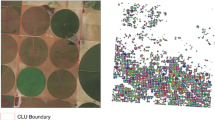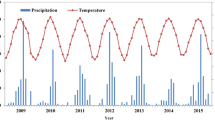Abstract
Within-field spatial variability reduces growers’ return on investment and overall productivity while potentially increasing negative environmental impacts through increased soil erosion, nutrient runoff, and leaching. The hypothesis that integrating energy crops into non-profitable segments of agricultural fields could potentially increase grain yield and biomass feedstock production was tested in this study using a statewide analysis of predominantly corn- and soy-producing counties in Iowa. Basic and rigorous controls on permissible soil and soil-carbon losses were imposed on harvest of crop residues to enhance year-to-year sustainability of crop and residue production. Additional criteria limiting harvesting costs and focus on large-area subfields for biomass production were imposed to reduce the impacts of energy crop integration on grain production. Model simulations were conducted using 4 years (2013–2016) of soil, weather, crop yield, and management practice data on all counties in Iowa. Miscanthus (Miscanthus x giganteus), switchgrass (Panicum virgatum), and crop-residue-based bioenergy feedstock systems were evaluated as biomass. Average energy crop and plant residue harvesting efficiencies were estimated at 50 and 60%, respectively. Because of higher potential yields, average logistics costs for miscanthus-based biomass production were 15 and 23% lower than switchgrass-based and crop residue-based biomass productions, respectively, under basic sustainability controls, and 17 and 26% lower under rigorous sustainability controls. Subfield shape, size, area, and harvest equipment size were the dominant factors influencing harvesting cost and efficiency suggesting that in areas where subfields are predominantly profitable or harvesting efficiencies low, other options such as prairie strips, buffer zones around fields, and riparian areas should be investigated for more profitable biomass production and sustainable farming systems.









Similar content being viewed by others
References
Bonner IJ, Muth DJ, Tomer MD, James DE, Porter SA, Karelen DL (2014) Opportunities for energy crop production based on subfield scale distribution of profitability. Energies 7(10):6509–6526. https://doi.org/10.3390/en7106509
Nair SK, Hartley DS, Gardner TA, McNunn G, Searcy EM (2017) An integrated landscape management approach to sustainable bioenergy production. BioEnergy Res 10(3):929–948. https://doi.org/10.1007/s12155-017-9854-3.
Muth DJ, McCorkle DS, Koch JB, Bryden KM (2012) Modeling sustainable agricultural residue removal at the subfield scale. Agron J 104(4):970
Sanchez OJ, Cardona CA (2007) Trends in biotechnological production of fuel ethanol from different feedstocks. Bioresour Technol 99(13):5270–5295. https://doi.org/10.1016/j.biortech.2007.11.013
Hill J, Nelson E, Tilman D, Polasky S, Tiffany D (2006) Environmental, economic, and energetic costs and benefits of biodiesel and ethanol biofuels. Proc Natl Acad Sci U S A 103(30):11206–11210. https://doi.org/10.1073/pnas.0604600103
Mussatto SI, Dragone G, Guimaraes PMR, Silva JPA, Carneiro LM, Roberto IC, Vicente A, Domingues L, Teixeira JA (2010) Technological trends, global market, and challenges of bioethanol production. Biotechnol Adv 28(6):817–830. https://doi.org/10.1016/j.biotechadv.2010.07.001
Demirbas MF, Balat M (2005) Recent advances on the production and utilization trends in biofuels: a global perspective. Energy Conserv Manag 47(15-16):2371–2381. https://doi.org/10.1016/j.enconman.2005.11.014
McPhail LL, Babcock BA (2011) Impact of US biofuel policy on US corn and gasoline price variability. Energy 37(1):505–513. https://doi.org/10.1016/j.energy.2011.11.004
Condon N, Klemick H, Wolverton A (2014) Impacts of ethanol policy on corn prices: a review and meta-analysis of recent evidence. Food Policy 51(February):63–73. https://doi.org/10.1016/j.foodpol.2014.12.007
Zulauf C (2016) US corn ethanol market: understanding the past to assess the future. Farmdoc Daily (6):218, http://farmdocdaily.illinois.edu/2016/11/us-corn-ethanol-market-past-and-future.html
Wisner R (2008) Impact of biofuels on corn and soybean prices. In September Issue of AgMRC, Agricultural Marketing Resource Center. http://farmdocdaily.illinois.edu/2016/11/us-corn-ethanol-market-past-and-future.html
Lark TJ, Salmon JM, Gibbs HK (2015) Cropland expansion outpaces agricultural and biofuel policies in the United States. Environ Res Lett 10:044003
Donner SD, Kucharik CJ (2008) Corn-based ethanol production compromises goal of reducing nitrogen export by the Mississippi River. Proc Natl Acad Sci U S A 105:4513–4518
Dale VH, Kling C, Meyer JL, Sanders J, Stallworth H, Armitage T, Wangsness D, Bianchi T, Blumberg A, Boynton W, Conley DJ, Crumpton W, David MB, Gilbert D, Howarth RW, Lowrance R, Mankin K, Opaluch J, Pearl H, Reckhow K, Sharpley AN, Simpson TW, Snyder C, Wright D (2010) Hypoxia in the Northern Gulf of Mexico. Springer Series on Environmental Management. ISBN 0172-6161, ISBN 978-0-387-89685-4, e-ISBN 978–0–387-89686-1. Springer, New York. https://doi.org/10.1007/978-0-387-89686-1
Smith VH, Tilman GD, Nekola JC (1999) Eutrophication: impacts of excess nutrient inputs on freshwater, marine, and terrestrial ecosystems. Environ Pollut 100(1–3):179–196
Min QW, Jiao YL (2002) Effects of agricultural non-point source pollution on eutrophication of water body and its control measure. Acta Ecol Sin 22(03):291–299
Jager HI, Baskaran LM, Schweizer PE, Turhollow AF, Brandt CC, Srinivasan R (2015) Forecasting changes in water quality in rivers associated with growing biofuels in the Arkansas-White-Red river drainage, USA. GCB Bioenergy 7:774–784. https://doi.org/10.1111/gcbb.12169
Dodds WK, Oakes RM (2008) Headwater influences on downstream water quality. Environ Manag 41:367–377
Negri MC (2016) Bioenergy sustaianbility and the food, energy, land and water nexus. Presented at DOE’s Bioenergy Solutions to Gulf Hypoxia Workshop. Aug 30–31, 2016, Washington, DC
Wu M (2016) Modeling water quality in the Mississippi River Basin: Upper Mississippi, Ohio, and Missouri River Basins. Presented at DOE’s Bioenergy Solutions to Gulf Hypoxia Workshop. Aug 30–31, 2016, Washington, DC
McIsaac GF (2016) Framing the problem: nutrient source identification, accounting, and attribution. Presented at DOE’s Bioenergy Solutions to Gulf Hypoxia Workshop. Aug 30–31, 2016, Washington, DC
Demissie Y, Yan E, Wu M, Zhang Z (2012) Watershed modeling of potential impacts of biofuel feedstock production in the Upper Mississippi River Basin. Environmental Sciences Division, Argonne National Laboratory Report, ANL/EVS/AGEM/TR-12-07, April 2012
Nocentini A, Virgilio ND, Monti A (2015) Model simulation of cumulative carbon sequestration by switchgrass (Panicum virgatum L.) in the Mediterranean area using the DAYSENT model. Bioenerg Res 8:1512–1522. https://doi.org/10.1007/s12155-015-9672-4
Cosentino SL, Copani V, Scalici G, Scordia D, Testa G (2015) Soil erosion mitigation by perennial species under Mediterranean environment. Bioenerg Res 8:1538–1547
Brye KE, Norman JM, Bundy LG, Gower ST (2000) Nitrogen and carbon leaching in agroecosystems and their role in denitrification potential. J Environ Qual 1(3):58–70. https://doi.org/10.2134/jeq2001.30158x
Gelfand I, Zenone T, Jasrotia P, Chen J, Hamilton SK, Robertson GP (2011) Carbon debt of conservation reserve program (CRP) grasslands converted to bioenergy production. Proc Natl Acad Sci U S A 108(33):13864–13869
Koph I, Lonsdorf EV, Williams NM, Brittain C, Isaacs R, Gibbs J, Ricketts TH (2015) Modeling the status, trends, and impacts of wild bee abundance in the United States. PNAS 113(1):140–145. https://doi.org/10.1073/pnas.1517685113
Brittain C, Potts SG (2010) The potential impacts of insecticides on the life-history traits of bees and the consequences for pollination. Basic Appl Ecol 12(4):321–331. https://doi.org/10.1016/j.baae.2010.12.004
White S (2017) Biofuels phase-out will raise demand for feed imports, industry warns. In EURACTIV.com. https://www.euractiv.com/section/agriculture-food/news/biofuels-phase-out-will-increase-demand-for-feed-imports-industry-warns/
Bonner IJ, Mcunn G, Muth DJ, Tyner W, Leirer J, Dakins M (2016) Development of integrated bioenergy production systems using precision conservation and multimedia decision analysis techniques. J Soil Water Conserv 71(3):180–191
Brandes E, McNunn GS, Schulte IA, Bonner IJ, Muth DJ, Babcock BA, Sharma B, Heaton EA (2016) Subfield profitability analysis reveals an economic case for cropland diversification. Environ Res Lett 11(2016):014009
Iowa Nutrient Reduction Strategy (2013) A science and technology-based framework to assess and reduce nutrients to Iowa waters and the Gulf of Mexico. Iowa Dept. of Agriculture and Land Stewardship, Iowa Dept. of Natural Resources and Iowa State University College of Agriculture and Life Sciences (www.nutrientstrategy.iastate.edu)
Muth DJ, Bryden KM (2013) An integrated model for assessment of sustainable agricultural residue removal limits for bioenergy systems. Environ Model Softw 39:50–69
Muth DJ, Bryden KM, Nelson RG (2013) Sustainable agricultural residue removal for bioenergy: a spatially comprehensive US national assessment. Appl Energy 102:403–417
McKendry P (2002) Energy production from biomass (part 1): overview of biomass. Bioresour Technol 83(1):37–46
USDA National Agricultural Statistics Service Cropland Data Layer (2016) Published crop-specific data layer. Available at https://nassgeodata.gmu.edu/CropScape/. USDA-NASS, Washington, DC
Revised universal soil loss equation, version 2 (RUSLE2), Official NRCS RUSLE2 Program Official NRCS Database http://fargo.nserl.purdue.edu/rusle2_dataweb/RUSLE2_Index.htm
Scheffe L, Ferruzzi G, Boetger S, Woodruff S (2015) RUSLE2 advanced data management. http://fargo.nserl.purdue.edu/RUSLE2_ftp/NRCS_Base_Database/RUSLE2%20Instructional%20Material/Training%20Presentations/RUSLE2%20Advanced%20Data%20Management.pptx
Miller GA, Fenton TE, Oneal BR, Tiffany BJ, Burras CL (2010) Iowa soil properties and interpretations database. ISPAID Version 7
Plastina A (2015-2016) Estimated costs of crop production in Iowa. Ag decision maker. Available at https://www.extension.iastate.edu/agdm/crops/html/a1-20.html
Duffy M (2013-2014) Estimated costs of crop production in Iowa. Ag decision maker. Available at http://econ2.econ.iastate.edu/faculty/duffy/extensionnew.html
Edwards W, Johanns A, Chamra A, Neighbor J (2013) Cash rental rates for Iowa. Ag decision maker. Available at https://www.extension.iastate.edu/agdm/wholefarm/pdf/c2-10_2013.pdf
Edwards W, Johanns A, Neighbor J (2014) Cash rental rates for Iowa. Ag decision maker. Available at https://www.extension.iastate.edu/agdm/wholefarm/pdf/c2-10_2014.pdf
Plastina A, Edwards W, Johanns A (2015) Cash rental rates for Iowa. Ag decision maker. Available at https://www.extension.iastate.edu/agdm/wholefarm/pdf/c2-10_2015.pdf
Plastina A, Johanns A, Welter C (2016) Cash rental rates for Iowa. Ag decision maker. Available at https://www.extension.iastate.edu/agdm/wholefarm/pdf/c2-10_2016.pdf
Mitchell RB, Schmer MR, Anderson WF, Jin V, Blakcom KS, Kiniry J (2016) Dedicated energy crops and crop residues for bioenergy feedstocks in the central and eastern USA. Bioenerg Res 9:384–398. https://doi.org/10.1007/s12155-016-9734-2
Langholtz MH, Stokes BJ, Eaton LM (2016) 2016 billion-ton report: advancing domestic resources for a thriving bioeconomy, volume 1: economic availability of feedstock. OAK RIDGE NATIONAL LABORATORY, Oak Ridge, Tennessee, managed by UT-Battelle, LLC for the US DEPARTMENT OF ENERGY, 2016, 1–411
Jacobson JJ, Roni MS, Lamers P, Cafferty KG (2014) Biomass feedstock and conversion supply system design and analysis. Idaho National Laboratory, Idaho Falls INL/EXT-14-32377
Cafferty KG, Muth DJ, Jacobson JJ, Bryden KM (2013a) Model based biomass system design of feedstock supply systems for bioenergy production. In: ASME 2013 International Design Engineering Technical Conferences and Computers and Information in Engineering Conference, August 4–7, Portland, OR, USA
Ferrarini A, Fornasir F, Serra P, Ferrari F, Trevisan M, Amaducci S (2017) Impacts of willow and miscanthus bioenergy buffers on biogeochemical N removal processes along the soil-groundwater continuum. GCB Bioenergy 9(1):246–261
Schroeder J (2010) The pros and cons of miscanthus. In http://energy.agwired.com/2010/09/09/the-pros-cons-of-miscanthus/. Accessed March 2018
Song L (2010) Study: Miscanthus guzzles more water than corn but soaks up more nitrates too. In Inside Climate News, October 4, 2010. https://insideclimatenews.org/news/20101004/study-miscanthus-guzzles-more-water-corn-soaks-more-nitrates-too. Accessed March 2018
Schultz RC, Collettil JP, Isenhart TM, Simpkins WW, Mize CW, Thompson ML (1995) Design and placement of a multi-species riparian buffer strip system. Agrofor Syst 29(3):201–226
Ssegane H, Negri CM (2016) An integrated landscape designed for commodity and bioenergy crops for a tile-drained agricultural watershed. J Environ Qual 45(5):1588–1596. https://doi.org/10.2134/jeq2015.10.0518
Wightman JL, Ahmed ZU, Volk TA, Castellano PJ, Peters CJ, DeGloria AD, Duxbury JM, Woddbury PB (2015) Assessing sustainable bioenergy feedstock production potential by integrated geospatial analysis of land use and land quality. Bioenerg Res 8:1671–1680. https://doi.org/10.1007/s12155-015-9618-x
Acknowledgments
This work was supported by the US Department of Energy’s Office of Energy Efficiency and Renewable Energy, Bioenergy Technologies Office, under DOE Idaho Operations Office Contract DE-AC07-05ID14517. Accordingly, the US Government retains a nonexclusive, royalty-free license to publish or reproduce the published form of this contribution, or allow others to do so, for US Government purposes. The authors would also like to acknowledge the analytical support provided by AgSolver to this study.
Author information
Authors and Affiliations
Corresponding author
Rights and permissions
About this article
Cite this article
Nair, S.K., Griffel, L.M., Hartley, D.S. et al. Investigating the Efficacy of Integrating Energy Crops into Non-Profitable Subfields in Iowa. Bioenerg. Res. 11, 623–637 (2018). https://doi.org/10.1007/s12155-018-9925-0
Published:
Issue Date:
DOI: https://doi.org/10.1007/s12155-018-9925-0




